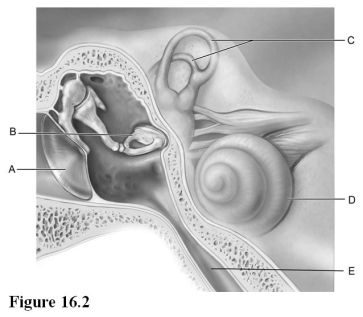A) medially.
B) superiorly.
C) inferiorly.
D) laterally.
F) A) and C)
Correct Answer

verified
Correct Answer
verified
True/False
The hair cells of the inner ear are gradually lost with advancing age and do not regenerate.
B) False
Correct Answer

verified
Correct Answer
verified
Multiple Choice
Which of the following statements does not correctly describe the spiral organ?
A) High-frequency sounds stimulate hair cells at the basal end of the basilar membrane.
B) The "hairs" of the receptor cells are embedded in the tectorial membrane.
C) The spiral organ is part of the cochlear duct, which is also called the scala media.
D) The tectorial membrane bends with vibrations, whereas the basilar membrane is rigid and fixed.
F) B) and C)
Correct Answer

verified
Correct Answer
verified
Short Answer
Smell is closely associated with the ________ region of the brain, which controls emotional responses.
Correct Answer

verified
Correct Answer
verified
Multiple Choice
The nerve carrying taste information from the anterior two-thirds of the tongue is the
A) hypoglossal.
B) glossopharyngeal.
C) olfactory.
D) facial.
F) A) and C)
Correct Answer

verified
Correct Answer
verified
Multiple Choice
Gustatory cells are located in all of the following areas except
A) on the apical surface of vallate papillae on the tongue.
B) on the fungiform papillae of the anterior tongue.
C) on the inner surface of the cheeks.
D) on the posterior wall of the pharynx.
F) A) and D)
Correct Answer

verified
Correct Answer
verified
Multiple Choice
An essential part of the maculae involved in static equilibrium is/are the
A) spiral organ.
B) cupula.
C) scala media.
D) otoliths.
F) B) and D)
Correct Answer

verified
Correct Answer
verified
Multiple Choice
Which of these is true regarding the development of the ear?
A) The internal aspect of the ear forms from the otic placode, a thickening of the surface ectoderm.
B) The ear begins to form in the 8th week of development.
C) The external acoustic meatus develops from mesoderm.
D) The auricle develops from the otic pit.
F) B) and C)
Correct Answer

verified
Correct Answer
verified
Multiple Choice
The bony labyrinth structure containing the utricle and saccule is called the
A) vestibule
B) macula lutea
C) macula densa
D) ora serrate
E) scala vestibule
G) C) and D)
Correct Answer

verified
Correct Answer
verified
Short Answer
The lens of the eye is attached to string like ________, which are anchored by ciliary bodies attached to the sclera.
Correct Answer

verified
Correct Answer
verified
Multiple Choice
Of the following structures, which is the only one that contains perilymph (instead of endolymph) ?
A) scala media
B) saccule
C) scala tympani
D) semicircular ducts
F) B) and D)
Correct Answer

verified
Correct Answer
verified
Multiple Choice
 Use the diagram above to answer the following questions.
-Identify the letter that indicates the structure that contains receptors for rotational acceleration.
Use the diagram above to answer the following questions.
-Identify the letter that indicates the structure that contains receptors for rotational acceleration.
A) A
B) B
C) C
D) D
E) E
G) A) and B)
Correct Answer

verified
Correct Answer
verified
True/False
The tips of cochlear hair cells are embedded in the basilar membrane.
B) False
Correct Answer

verified
Correct Answer
verified
Multiple Choice
The external ear consists of each of the following structures except the
A) auricle.
B) helix.
C) lobule.
D) vestibule.
F) A) and C)
Correct Answer

verified
Correct Answer
verified
Short Answer
The special sense most like gustation (taste) in terms of type of receptor is ________.
Correct Answer

verified
Correct Answer
verified
Multiple Choice
Of the following glands, which does not help keep the anterior part of the eye from drying out?
A) lacrimal caruncle
B) tarsal glands
C) goblet cells in the conjunctiva
D) lacrimal gland
F) None of the above
Correct Answer

verified
Correct Answer
verified
Multiple Choice
 Use the diagram above to answer the following questions.
-Identify the letter that indicates the structure that is called the cochlea.
Use the diagram above to answer the following questions.
-Identify the letter that indicates the structure that is called the cochlea.
A) A
B) B
C) C
D) D
E) E
G) A) and C)
Correct Answer

verified
Correct Answer
verified
Multiple Choice
The middle ear cavity is normally filled with
A) perilymph.
B) endolymph.
C) air.
D) mucus.
F) B) and D)
Correct Answer

verified
Correct Answer
verified
Multiple Choice
Which of these is true regarding the chemical senses, olfaction and taste, throughout life?
A) Children have more taste buds than adults.
B) The number of olfactory cells increases throughout life, so the elderly have an exceptionally good sense of smell.
C) The sense of smell is very weak in young children.
D) The number of taste receptors stays constant throughout life.
F) C) and D)
Correct Answer

verified
Correct Answer
verified
Multiple Choice
 Use the diagram above to answer the following questions.
-Identify the letter that indicates the structure that is important in equalizing air pressure on both sides of the eardrum.
Use the diagram above to answer the following questions.
-Identify the letter that indicates the structure that is important in equalizing air pressure on both sides of the eardrum.
A) A
B) B
C) C
D) D
E) E
G) A) and C)
Correct Answer

verified
Correct Answer
verified
Showing 61 - 80 of 114
Related Exams